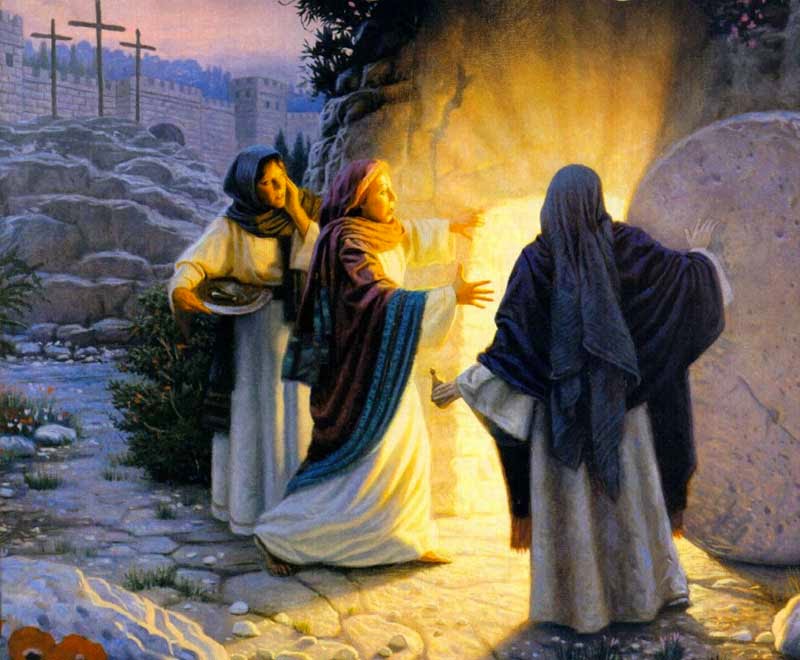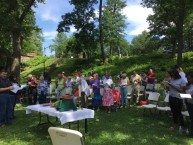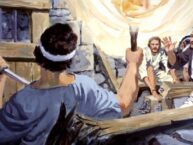 Easter Sunday – March 31, 2024: Alleluia, Christ is Risen! He is risen indeed. Alleluia! Amen.
Easter Sunday – March 31, 2024: Alleluia, Christ is Risen! He is risen indeed. Alleluia! Amen.
Well, that’s a really strange ending to this gospel’s resurrection narrative! Is it any wonder why later scribes added a tweak or two to the ending?
Just look at that last part, where it says that Mary Magdalene, Mary the mother of James, and Salome “…went out and fled from the tomb, for terror and amazement had seized them; and they said nothing to anyone, for they were afraid.”
Now – that’s a bit of a problem, right?
I mean, if they told no one – what the heck are you’all doing here?
Obviously – somebody told somebody something, right?
Well, that’s why we get the added on sections, known as the Shorter Ending of Mark and the Longer Ending of Mark – clearly, these later authors were not big on creative marketing. Here is how those added bits went:
Mary Magdalene actually did tell the rest of the disciples. They rolled their eyes.
Now, just an aside, this outta have been a great time for Peter to make amends for his denial of Jesus three times. Maybe jumping up like Ron Wesley supporting Hermione Granger in The Deathly Hallows, after he had really, really, messed up. Peter could be like that and say “I believe Mary. Let’s take a vote! Now, all in favor…”
But noooooo.
Continuing on, Jesus appeared to two others on the road– perhaps Cleopas and his wife on the road to Emmaus – They told the disciples. Again, the disciples wouldn’t believe it.
Jesus then figured it was time for a holy smack down of those 11 guys. What a scene THAT must have been
On the whole, I’d like to say that it was a nice gift by this author to those 11 guys hiding away in Jerusalem not to mention their disbelief of Mary Magdalene or the other two, but it kinda did throw them all under the disciple bus.
What a story in Women’s History Month. Which reminds me of a meme I saw on Threads the other day, which read: “Women – Celebrate Women’s History month by interrupting men with your unsolicited opinions and taking credit for their work. If they get upset about it, tell them they sound hysterical and should smile more.” I think Mary Magdalene would drop a mic on that one.
The truth is though, maybe the author of Mark had the ending right all along. No, not in making it seem the women would be too afraid to tell anyone. Lord knows, and he does, it was the women who stood courageously at the foot of the cross, and came to the tomb as soon as the sabbath was over. Neither were safe to do. Perhaps that is why it was the women, in every gospel account, who are the first to receive the good news of the resurrection. Jesus knew he could count on them.
No, the reason the original ending works is because of the beginning.
This gospel doesn’t start with a narrative of Christ’s birth, genealogy, or a long hymn to the wonder of the incarnation. It starts with the immediacy, directness, and brevity we get in the rest of it. The gospel opens with “The beginning of the good news of Jesus Christ, the Son of God.”
Now some might take that to be the opening of the first chapter, a biblical “Once upon a time” or “A long time ago, in a galaxy far, far away…”. Perhaps they are right. But, I would argue it is actually the title – because of the way the gospel ended.
Yes, it does sound like circular reasoning, that the ending is because of the beginning, which is because of the ending. And on this glorious day of resurrection, you might be thinking – so what?
Here’s the thing though – even while many come to church on Easter Sunday, enjoying all that this service brings to ones heart and mind, it can be hard to take in this story of the empty tomb, if we are really being honest. In our hearts we may feel the resurrection – the real presence of Jesus – but our heads sometimes find it all beyond comprehension. Which is why the ending of this story is so important, and points us back to the beginning. While that does sound like something Yoda the Jedi Master might say, “The ending not, the beginning it is,” perhaps this story will help.
In your Easter newsletter, both our Wardens wrote wonderful articles, and I commend them to you. Tom Reynolds – our livestream tech whose wife Amy is over there ushering – wrote something that touches on this very point about the resurrection. I will share a bit of it with you, but I hope you read it in full.
He wrote: “The other day, I was driving to the nursery school [of our church] to drop Sophia off, and she said, “Grandma is my best friend.” It hit me like a ton of bricks. My grandmother has been gone for six months, and Sophia starts the morning with this?! “Grandma says I have to go to school.” She continues. I felt the tears choke back as I tried to keep my vision from blurring coming down Hillside Ave. “What else did Grandma say?” I ask with a cracked voice. “Grandma says ‘I love you.’” [She replied.]
I’m glad the light was red, and I could collect myself then.
Tom continued “I think about moments like that as we come into this Easter season, this Resurrection season. We could put too much emphasis on the word resurrection; it feels heavy. It draws images of unthinkable acts or something we can dismiss because I’ve never seen a resurrected person before… They placed the lifeless body in the tomb and sealed it up. And then he was resurrected. Or, in my context, we buried my grandmother’s body, and now she is speaking through my child—the impossible.
But maybe that’s what Easter is about—taking a brief moment to believe the impossible. Like the line from Alice in Wonderland, “Why, sometimes I’ve believed as many as six impossible things before breakfast.”
The thing that struck me most in Tom’s story is at the stop light. He has heard something beyond comprehension – that someone he loves deeply, who has died, is still alive, though not in the way he knew her in her earthly life. He needed to stop – to take a breath – to process what it was he was hearing, before he could move on to what was next.
Now remember what happened with Mary Magdalene and the other women. They went to anoint Jesus, whom they had seen die a brutal death. The heavy stone that closed the tomb was gone. And they are told, in a strange scene with what other gospels describe as an angel – that he is risen – he’s alive! Not only that, but Jesus is on the loose! He is heading to Galilee.
The original ending was their stoplight moment – they went out and fled from the tomb, for terror and amazement had seized them; and they said nothing to anyone, for they were afraid.”
But while this unimaginable experience froze them for a moment, clearly it didn’t end there. Not for them, or for Tom.
The thing is, when we encounter the incomprehensible, all of us need time to catch our breath, to replay what just happened in our minds, to consider what it means for us. In that moment we are often silent. Sometimes out of choice, but usually because we can’t really figure out how to put the experience into words.
But once we do – once we find our voice – what was once incomprehensible becomes just the beginning of the story as the experience shapes our lives in ways unimaginable.
That is what the good news of Jesus Christ, the son of God, does.
That is the power of the cross and the empty tomb.
So, all the later scribes needed to do was end with the start, because the ending is the beginning.
The ending is an invitation to continue the story ourselves – to spend time here taking in the incomprehensible – experiencing of the real presence of Christ in the Eucharist – to pause from the craziness of the day at this proverbial stop light and allow ourselves to be amazed. To believe the impossible, precisely because we know that the impossible is only that which our own minds are not yet capable of understanding.
And then…be the beginning of the good news.
Be like Tom and believe in the seemingly impossible and tell others about it.
Be like Sophia and tell others that “God says, I love you!”
Why? Why should we do this?
Because this type of transformative experience needs to be shared in a world where so many live in despair and hopelessness.
Because the unconditional love and grace of God – who chose to dwell among us, even knowing the painful cost – is the balm the wounded souls of the marginalized and oppressed need.
Because those stoplight moments are what can turn lives around, especially our own – and change what seems impossible into lived reality.
Because once we know the power of Christ’s resurrection – that awe inspiring, incomprehensible, mind blowing reality – then we also know that hate will always be defeated by love, light will always overcome darkness, and death never, ever, has the last word.
This is the beginning of the good news of Jesus Christ, the Son of God!
Now it is up to us to continue the story.
So let us proclaim loud and clear for all the whole world that…
Christ is risen! He is risen indeed! Alleluia!
Christ is risen! He is risen indeed! Alleluia!
Christ is risen! He is risen indeed! Alleluia!
Happy Easter everyone.
Amen.
For the audio, click below, or subscribe to our iTunes Sermon Podcast by clicking here (also available on Audible):
The Rev. Diana L. Wilcox
Christ Church in Bloomfield & Glen Ridge
March 31, 2024
Easter Sunday
1st Reading – Acts 10:34-43
2nd Reading – 1 Corinthians 15:1-11
Gospel – Mark 16:1-8





